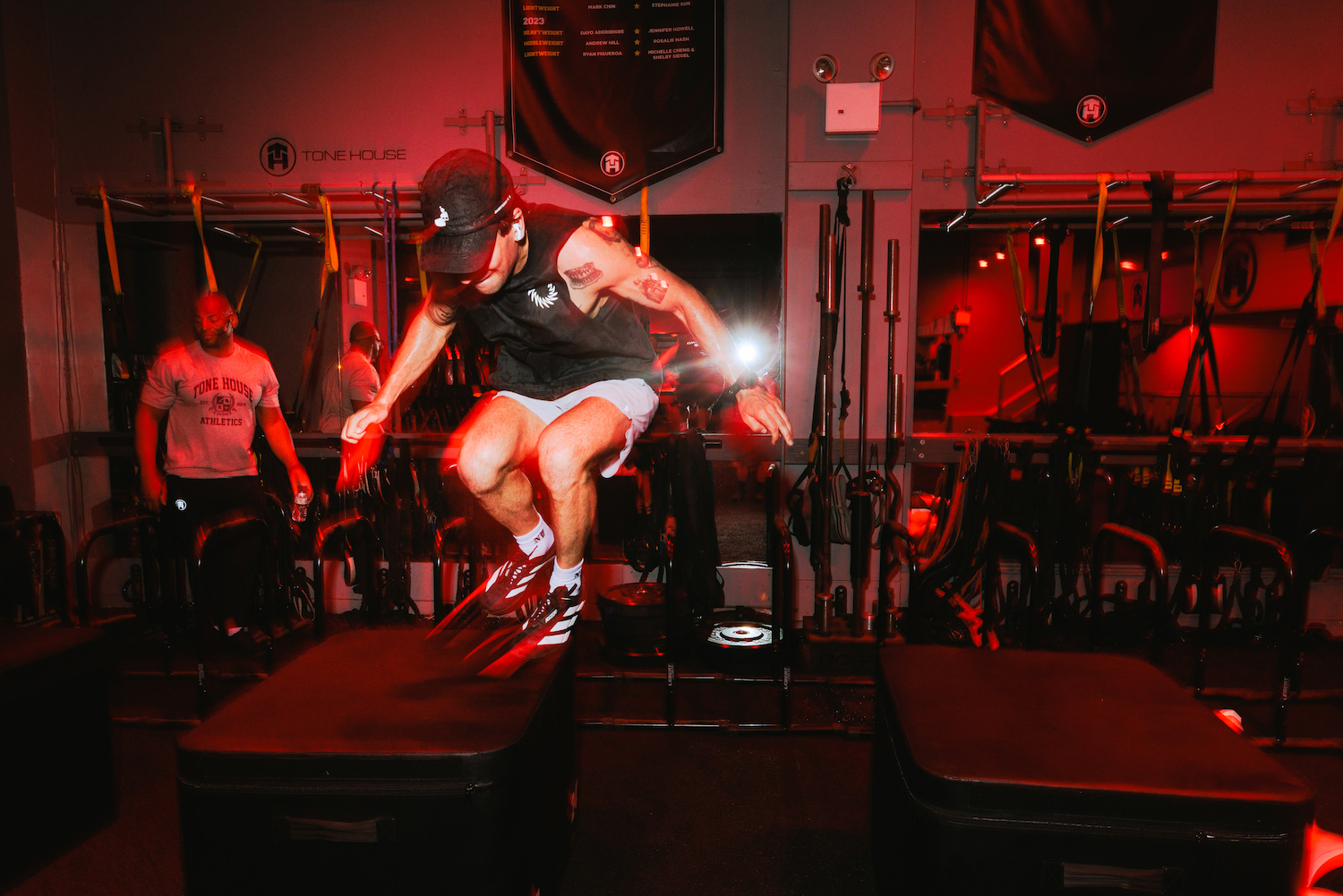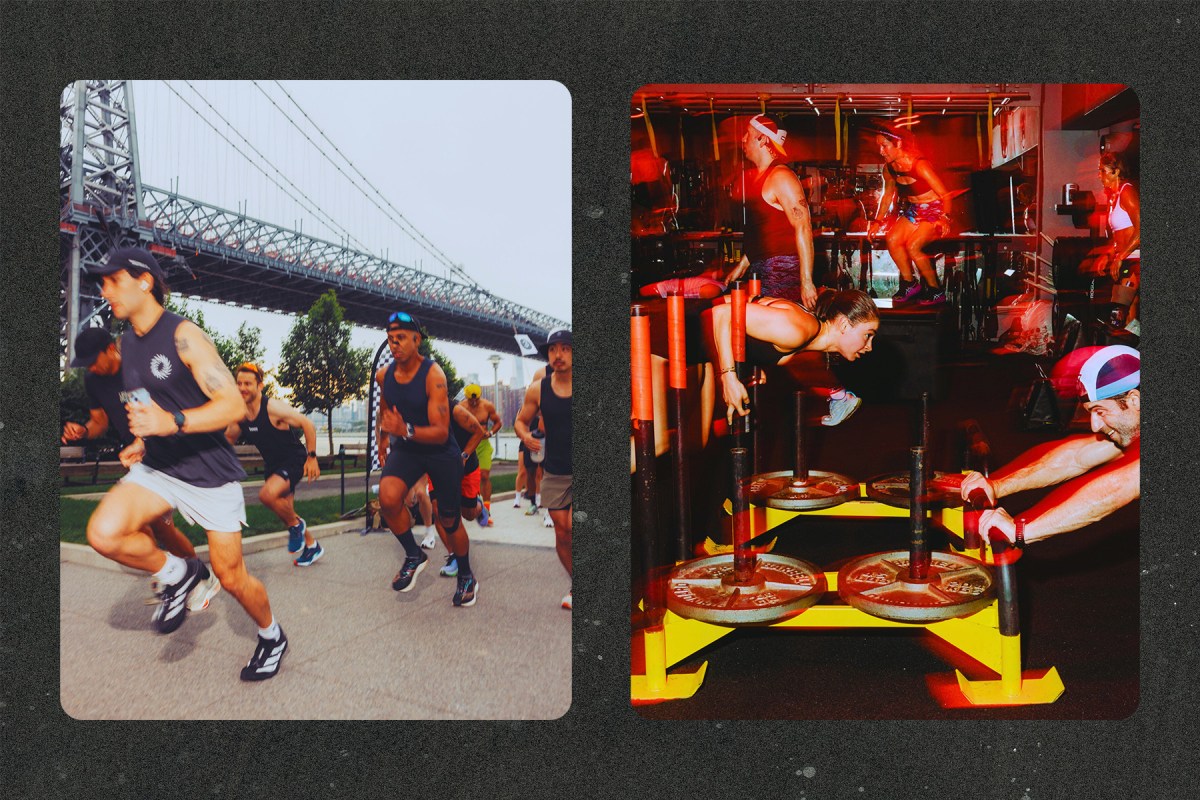This past October, on a chilly Sunday morning, 150 people gathered at the Rivian dealership in Williamsburg, New York. The perfectly lit showroom buzzed with anticipation as attendees plotted their routes, but nobody was there to test-drive a new electric car.
The location served as the starting point for Urban Iron, the latest addition to a bustling category of hybrid racing events that combine running with functional fitness. To overstate the current popularity of these types of events is almost as difficult as completing a hybrid race itself. While Urban Iron participants laced up at the Brooklyn dealership, 250 like-minded athletes toed a different starting line halfway across the country, ready to kick the tires of LIFE TIME’s inaugural LT Games in Minneapolis. Meanwhile, HYROX, the brand that arguably started it all, was simultaneously hosting two races in Paris and Birmingham.
The seemingly sudden ubiquity of hybrid races feels a lot like the obstacle course racing boom of the early 2010s — pioneered by Tough Mudder, with Warrior Dash, Spartan Race and Rugged Maniac quickly piling in. And yet, despite the growing number of hybrid races vying for real estate on our calendars, Urban Iron stands apart as a refreshing anomaly.

The creative race series was founded in New York City.
Urban Iron
Free-Range, Locally Sourced Fitness
Whereas races like HYROX and the LT Games take place in closed venues, with participants making pit stops at neatly organized workout stations in between carefully measured runs on a treadmill or around a track, Urban Iron unleashes this format onto the city streets outside.
Over the course of roughly eight miles, athletes make brief stops at independent fitness studios along the way to knock out bite-size workouts. And similar to unsanctioned races put on by renegade road running outfits like Orchard Street Runners and Take The Bridge, the route you take to and from each studio is entirely up to you.
Similar to HYROX, the exercises are released in advance, allowing participants to train appropriately. But while HYROX uses the same eight exercises for every race, regardless of venue, Urban Iron takes a more home-grown approach by selecting movements that are central to each studio’s signature training style. At last month’s race in New York, participants did sandball slams, kettlebell swings and dumbbell presses at Session Training in Williamsburg; pull-ups, wall balls and sled pushes at Solace in Midtown; and walking lunges, cleans,and rows at MOTIVNY in SoHo.
Welding Communities Together
Urban Iron’s founders, Louisa Li and Jacob Schonberger, are somewhat hybrid entities themselves. Li, a financial consulting veteran, pivoted to teaching yoga in 2023 and recently launched Shanti House, a wellness community for startup founders. At the same time that Li was receiving her yoga certification, Schonberger, an Ironman triathlete, was finalizing the sale of his tech startup to Beehiiv, a digital newsletter platform where he currently heads up advertising operations.
The two crossed paths in New York City and eventually realized they shared a vision of combining the city’s surging run culture and well-established group fitness scene. “We were on a run, and that’s when the idea for Urban Iron came together,” recalls Li. They figured that with Li’s network of wellness brands and Schonberger’s successful track record in the startup space, it was worth a try.
“We realized that there was a really interesting opportunity to bring those communities together and also kind of latch onto what we’ve seen as a desire to find events, challenges and other ways to meet new people and do something different on the weekend that is not just drinking or going to a bar,” Schonberger says. “So we kind of just decided, ‘Hey, let’s try to string a bunch of this stuff together and see if it makes sense.’”
At first, it actually didn’t make sense. “We ran a pilot, just Louisa and I,” Schonberger recalls, “and it was literally us going to Barry’s Bootcamp, CycleBar, and a hot yoga class — all in a row.” The whole thing took way too long, and both Li and Schonberger were concerned that full-length classes might eclipse their budding brand’s personality. (Also, cycling shoes are annoying.) “Honestly, that didn’t work that well,” he says. “So we kind of morphed and iterated and landed on what Urban Iron is today.”

Unlike HYROX, Urban Iron events can feature completely different exercises.
Urban Iron
An Opportunity to Explore
Urban Iron is a race, no question. Times are recorded with chips and athletes vie for a spot on the podium. But the event’s reliance on local studios and businesses also provides an opportunity to experience a new city in a fun and unprecedented way — that closed-arena races miss out on entirely.
“My favorite thing about doing marathons or any kind of race in other cities is going to that city and learning about it through running, and I think this is the perfect kind of race to do that,” says Lindsey Fritz, a product marketing specialist at IBM, who competed in last month’s race and says she would be excited to sign up for future Urban Iron events in other cities. “You have to find your way, you’re running through the streets, you get to see the people, you get to see the buildings. It’s just the mix of everything that makes this a fun way to see a new city.”
Even for locals like Fritz, there’s the chance of discovering something new. “I kind of zig-zagged through SoHo and passed by a few restaurants and bars that I’ve never seen before, and I made a quick mental note to come back one day,” says New York-based personal trainer Milton Carnegie, who checked off his second Urban Iron race, having also competed in the series’ debut back in June. “They also had different gyms this time, so it was a different experience. I’d been to Solace, but not MOTIVNY. So I was like, ‘Oh, new gyms, new workouts — that’ll be fun!’”
Humans: the Other Race
Above all else, Urban Iron strives to help people tap into their community and make new connections. “Since COVID, everyone has been talking about this loneliness epidemic and how people are just craving real human connection — especially now, in the age of AI and everything that’s happening,” says Li.
With this in mind, and in stark contrast to more established races that hand you a medal at the finish line and send you on your way, Urban Iron offers organic opportunities for participants to interact with one another both during and after the race, including a full-fledged afterparty at the finish line — complete with a live DJ, cold plunges, compression boots, snacks and product samples from the event’s sponsors.
“It was an ideal post-race celebration,” says Fritz, “It was just like anything you wanted, it was at your fingertips — in terms of food, in terms of recovery, and then just, of course, in terms of vibes.”

Competitors hang out after the race — and cap off the day with a cold plunge.
Urban Iron
Forging Ahead
Urban Iron’s first two races have been based in New York, but the series is quickly gearing up for expansion, with the next race confirmed to take place in Austin and Chicago likely to follow. The number of available race bibs will probably also increase, to accommodate more athletes as word of the series inevitably spreads. The first race in June, which had just over 100 sign-ups, resulted in a 400-person waitlist for the next event. After selling out the 150 available spots for October’s race, Li and Schonberger are optimistic about the future.
“There are so many hybrid athlete hubs, and that’s why we’re going to Austin next,” says Li. “We look at HYROX — how they have expanded and the different cities that they’ve tapped into — and we know that there are markets where these types of people love to come together for a fun challenge. We know that there are other cities that would want this.”
Beyond Austin and Chicago, Li and Schonberger have their sights set on a second wave of events to potentially take place in cities including Los Angeles, Miami, DC, Denver and Boston. But New Yorkers needn’t fret. “New York City is like our home base,” says Li. “We want to continue doing the New York races every spring and fall.”
More Like This
The Charge will help you move better, think clearer and stay in the game longer. Subscribe to our wellness newsletter today.


